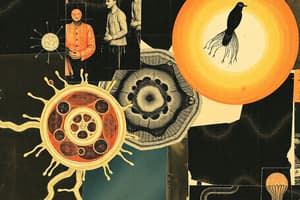Podcast
Questions and Answers
What is the primary function of mitochondria in a cell?
What is the primary function of mitochondria in a cell?
- Energy production (correct)
- Waste management
- Cell signaling
- Protein synthesis
Mitochondria are inherited from both parents.
Mitochondria are inherited from both parents.
False (B)
What is the term for the process of mitochondrial degradation and recycling?
What is the term for the process of mitochondrial degradation and recycling?
Mitophagy
The inner membrane of mitochondria is folded into ______________ to increase surface area.
The inner membrane of mitochondria is folded into ______________ to increase surface area.
Match the following mitochondrial functions with their descriptions:
Match the following mitochondrial functions with their descriptions:
Flashcards are hidden until you start studying
Study Notes
Mitochondria
Structure
- Double membrane-bound organelle
- Outer membrane: permeable, allows certain substances to pass through
- Inner membrane: impermeable, folded into cristae to increase surface area
- Inter membrane space: region between outer and inner membranes
- Matrix: innermost region, site of citric acid cycle and fatty acid oxidation
Function
- Energy production: generate most of cell's ATP through cellular respiration
- Aerobic respiration: break down glucose and other organic molecules to produce ATP
- Cell signaling: involved in cell growth, differentiation, and apoptosis
- Ion regulation: regulate ion concentrations, especially calcium, within the cell
Dynamics
- Mitochondrial dynamics: mitochondria can divide, fuse, and move within the cell
- Mitophagy: process of mitochondrial degradation and recycling
- Mitochondrial motility: movement of mitochondria along microtubules
Inheritance
- Maternal inheritance: mitochondria are inherited from mother, as only egg cell mitochondria survive fertilization
- Mitochondrial DNA: separate from nuclear DNA, responsible for some mitochondrial functions
Diseases and Disorders
- Mitochondrial myopathies: muscle disorders caused by mitochondrial dysfunction
- Mitochondrial neurodegenerative diseases: diseases such as Alzheimer's and Parkinson's linked to mitochondrial dysfunction
Mitochondria
Structure
- Mitochondria have a double membrane, with the outer membrane being permeable and the inner membrane being impermeable and folded into cristae to increase surface area.
- The intermembrane space is the region between the outer and inner membranes.
- The matrix is the innermost region of the mitochondria, where the citric acid cycle and fatty acid oxidation take place.
Function
- Mitochondria are the primary site of energy production, generating most of the cell's ATP through cellular respiration.
- They break down glucose and other organic molecules to produce ATP during aerobic respiration.
- Mitochondria are involved in cell signaling, playing a role in cell growth, differentiation, and apoptosis.
- They also regulate ion concentrations, particularly calcium, within the cell.
Dynamics
- Mitochondria are dynamic organelles that can divide, fuse, and move within the cell.
- Mitophagy is the process of mitochondrial degradation and recycling.
- Mitochondria can move along microtubules, a process known as mitochondrial motility.
Inheritance
- Mitochondria are inherited solely from the mother, as only egg cell mitochondria survive fertilization.
- Mitochondrial DNA is separate from nuclear DNA and is responsible for some mitochondrial functions.
Diseases and Disorders
- Mitochondrial dysfunction can lead to muscle disorders, known as mitochondrial myopathies.
- Mitochondrial neurodegenerative diseases, such as Alzheimer's and Parkinson's, have been linked to mitochondrial dysfunction.
Studying That Suits You
Use AI to generate personalized quizzes and flashcards to suit your learning preferences.




